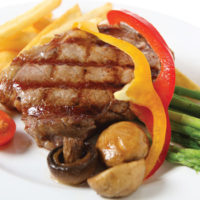Trends in Meat and Poultry Safety

In a day and age when consumers and foodservice experts are increasingly aware of food labels and seeking out better-for-you products with fewer artificial flavors or additives, the issue of phosphates should be brought to the table. Consumers and food professionals alike are calling for more natural ingredients in their meat and poultry to replace the chemical additives currently used. Phosphates are one of them. Without compromising flavor and other characteristics, Sunsweet plums are just the ingredients they are looking for.
Although numerous meat and poultry producers add phosphates, artificial preservatives and other chemicals to products to help with moisture retention and shelf life, Sunsweet’s plums are an effective substitute for these unwanted additives. Fresh plum concentrate, plum fiber, plum powder, and plum puree can be used to effectively bind moisture in animal proteins and contribute to true protein flavor, juiciness, texture, and eating quality.
Fresh Plum Concentrate
Made from the juice of fresh prune plums, this light-colored concentrate is the go-to plum ingredient for phosphate replacement in whole-muscle meat or poultry items. Used in a solution at 0.5 percent of the meat block, plum concentrate can be injected or vacuum tumbled into the meat. Its high malic acid content also allows for significant reductions in total added salt and seasonings. On a label, it typically can be listed as plum concentrate.
 Plum Fiber
Plum Fiber
Made from dehydrated prune pulp, this hygroscopic fiber can absorb about six times its weight, which not only helps meat products retain moisture but also allows seasoning rubs to stay on the surface of the meat instead of letting the salt in the rub draw out moisture and dislodge seasonings. When mixed into ground meat products, it helps retain moisture. And in a cook-in-bag product or a marinated raw product, it wicks away purge. On a label, it typically is listed as isolated plum product.
Plum Powder
Ground from whole prunes, plum powder is also extremely hygroscopic and performs well in wicking away purge in marinated raw products or cook-in-bag products. When used in seasoning rubs or mixed into ground meat, plum powder helps retain moisture. It is lighter and sweeter than plum fiber. Like fresh plum concentrate, it also decreases warmed-over flavor and its high malic acid content allows for reduction in salt and seasonings. On a label, it typically is listed as plum powder.
Plum Puree
This product is a blend of prunes and prune juice concentrate. When ground with meat or mixed into an emulsion with ice water, plum puree lowers drip loss in sausages and allows for reduction in total salt and seasoning quantities. On a label, it typically is listed as plum puree.
Holding the largest share of the protein market in the U.S., the need for more natural meats is especially apparent in poultry. Most major poultry processors now have natural poultry product lines due to increased push from consumers. As this push continues, there will be more incentives to replace chemical additives with more natural products.
Most raw, cooked, or frozen meat and poultry items contain some form of added moisture. Often this happens before a manufacturer receives the raw material. Chicken that has been soaked in a chill tank after slaughter can easily absorb 3 percent—though often more—of its weight in water before leaving a processing plant. The main reasons for adding moisture to meat and poultry items is texture, taste, and profitability. Moisture improves the sensory characteristics of a product. Lack of moisture means the product will be noticeably less tender, juicy, and flavorful. On the retail side, adding moisture allows room for error. If someone overcooks chicken at home, it will still be juicy. And more moisture means more weight and more pounds of product to sell. So for years, companies have looked for ways to add moisture to meat and poultry and minimize the amount of moisture lost during thawing or cooking processes.
There are several ways to add moisture to protein. Conventionally, manufacturers turned to phosphates and sodium. Phosphate ions react with meat proteins to bind moisture into the meat and lower drip loss and purge. Isolated soy protein (ISP), a binder that increases water retention, is also commonly used. To a lesser extent, carrageenan, gums, and starches are also put into play. It’s common to use a combination of all these components to reach desired moisture retention levels. To incorporate phosphates and other additives into meat, manufacturers vacuum tumble, inject, or soak meat in a solution.
That being said, consumers, nutritionists, and food professionals are asking for meat and poultry products with natural ingredients. Some want better-tasting products while others are looking for lower sodium products or allergen-free foods since consumers with soy allergies avoid ISP. As demand for healthful meat and poultry products increases, there is growing incentive to replace phosphates and conventional moisture-retaining binders with alternatives. For example, Sunsweet plum ingredients are natural, cost-neutral options that are just as effective at binding moisture into meat as phosphates. Phosphates can be used up to 0.5 percent of the weight of the meat block, although manufacturers tend to go just under to ensure they don’t unintentionally surpass that amount during processing. There is no limit on sodium. When used as a binder, plum ingredients are permitted up to 2 percent of the meat block, although recommended usage is 0.5 percent to 1.5 percent for most applications. When used as an ingredient for flavor, however, there is no limit on the quantity of plum. For instance, in a chicken sausage formula, the recommended quantity of plum puree is 3 percent.
Declaring the amount of moisture added to meat and poultry varies quite a bit depending on the kind of added moisture as well as the quantity and the type of protein. Generally speaking, the percentage of added moisture needs to be listed on the label. If chicken picks up water as it rests in a chill tank post-slaughter, the label may say “contains up to 8 percent retained water.” If the chicken picks up moisture from a phosphate solution applied during processing, the label may read “enhanced with up to 12 percent of a solution.” The term “marinade” can be used under a certain percentage of added moisture, and the percentages vary between meat and poultry. There is another important point to bring up about added moisture. While some additional moisture improves texture, too much causes the product to take on an unappealing, spongy texture. With poultry, for example, 8 to 10 percent is the sweet spot; beyond 18 percent and the product loses its integrity. Excess added moisture also makes it difficult to get meat or poultry to brown during the cooking process.
Approved by the U.S. Department of Agriculture, research has proven that substituting phosphates with products derived from dried plums will achieve moisture retention, while keeping meat products healthy and natural. Substituting dried plums also allows processors to enhance natural flavors and improve taste.
Moreover, research published in the Journal of Food Science conducted by the University of Arkansas-Fayetteville’s Food Science Department found that consumers found no difference when comparing the traditional, phosphate-filled product with the plum products replacing the phosphates.[1]
In addition, this multi-use ingredient nutritionally improves meat and poultry products by reducing fat, sodium, calories, artificial flavors and added colors. The best part about incorporating Sunsweet dried plums is that they are reasonably priced in a world of high quality foods. Substituting ingredients derived from dried plums is cost-neutral or even cost-favorable due to the competitive ingredient cost. Using Sunsweet dried plums results in fewer ingredients in formulas, less drip and cook loss, greater utilization of secondary cuts and lesser quality protein grades with higher finished protein qualities.
For more information, visit SunsweetIngredients.com.
References
1. http://www.californiadriedplums.org/media/c5d1d089/Tech%20Bulletin%20Phosphate%20Replacement.pdf.
Looking for a reprint of this article?
From high-res PDFs to custom plaques, order your copy today!




